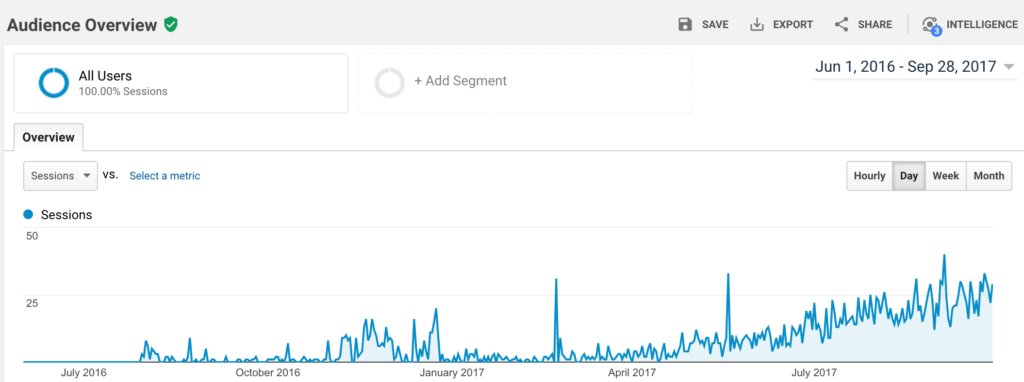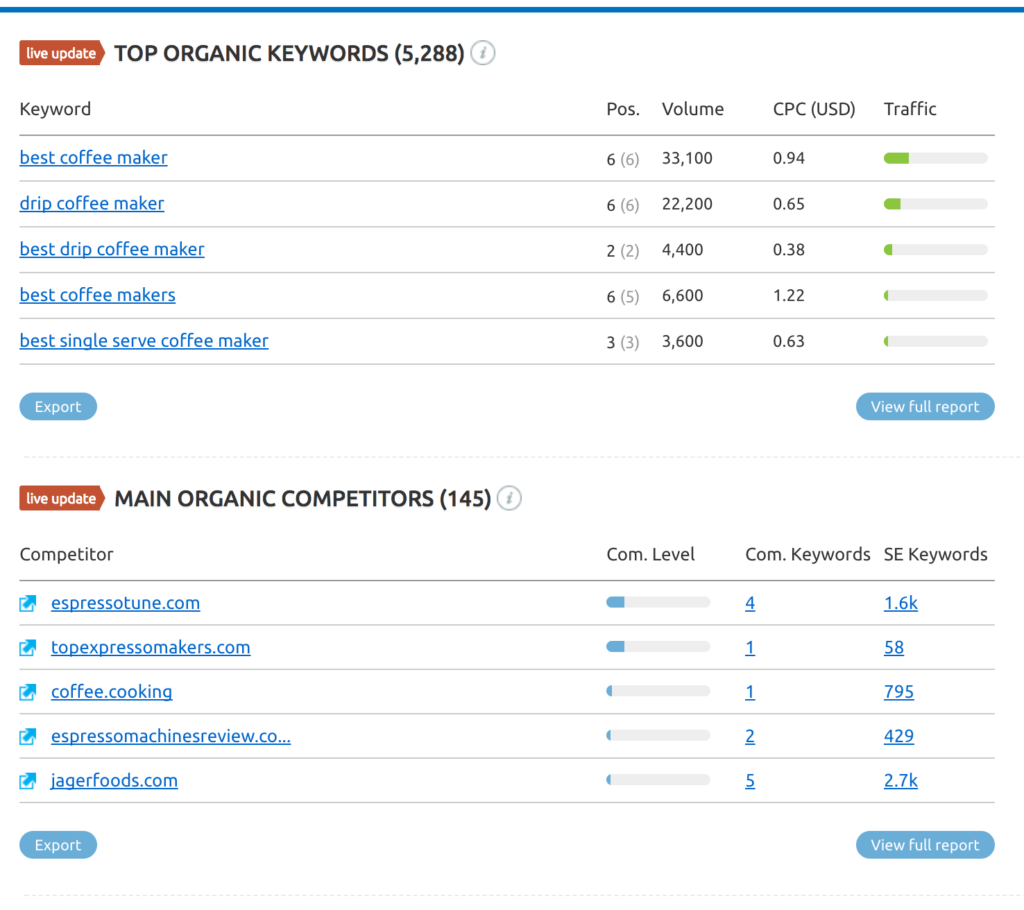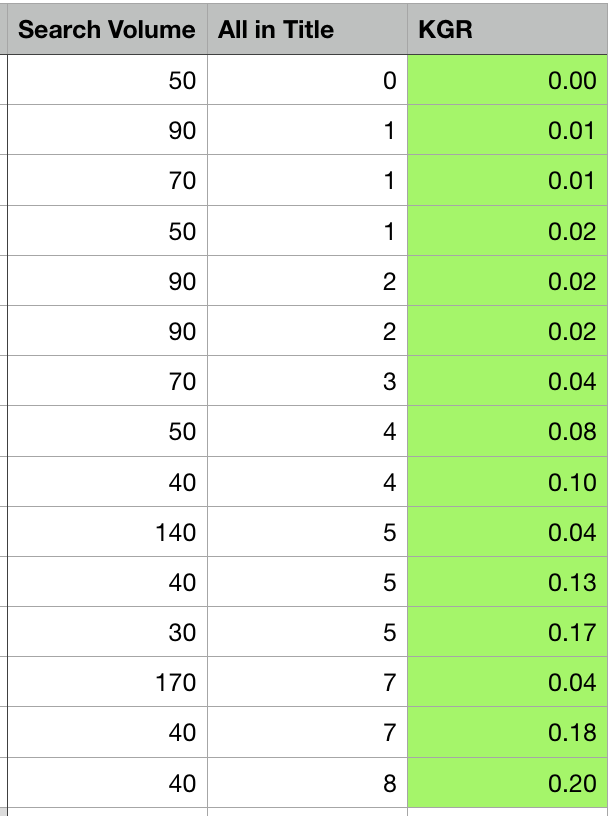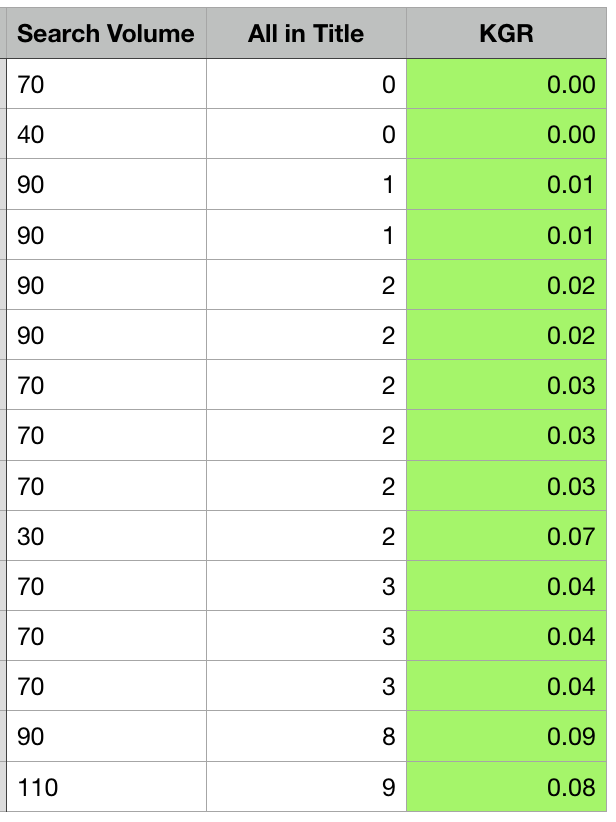Growing My Niche Site With KGR Articles
Since first hearing about the low all title keyword strategy from a podcast on Niche Pursuits I have found the whole concept really interesting as it’s a great way to grow your websites traffic. Claire’s particular podcast from Niche Pursuits was very popular for the reason that she NEVER built any backlinks to her site, she was just building out and managing multiple sites focus on targeting low all in title buying keywords. She reported that she was earning low five figures a month with the strategy which is very impressive!
The idea behind the strategy is that you research and target long tail keywords with lower search volume that have a very low all in title search on google, this is done by searching: “allintitle: keyword”

Here is an example of an allintitle query for a random phrase which has an allintitle of ’36’.
Keywords with a very low all in title are generally very easy to rank for as it means Google is starved for content for this particular keyword so if you put together a fairly decent article targeting the keyword then theoretically you should have a good chance of ranking for it.
Now Onto KGR’s
The strategy I have been implementing is targeting ‘KGR Keywords’ which is similar to Claire’s all in title strategy but more streamlined to give a data driven and precise target criteria on whether you should go after a particular keyword or not.
The KGR concept is something that I learnt from Doug Cunnington who has taught me a lot from his blog, his niche course and our one-to-one Skype sessions, Doug is well known for the KGR concept within the Niche site world too and rightly so as it’s a fantastic technique that yields great results.
If the Allintitle number (divided by) Search Volume is less than 0.25 and below then it would be classed as a KGR and a green light to go after the keyword as you will have a good chance to rank for it and get additional traffic to your site due to the low competition.
Here is an example of a KGR;

I added random words on the above keyword in order not to give away my Niche but you can see that this particular keyword gets 110 searches per month and has a low all in title of 15 which divided gives a KGR rating of 0.13 which is a green light to move forwards with as it’s below the 0.25 KGR criteria.
So the calculation on the above is 15 / 110 = 0.13.
I would really recommend that you check out this post from Doug as it covers KGR’s in a lot more detail by Doug himself, his site covers a ton of great Niche site information which I cannot recommend highly enough.
About The Site I Am Trying To Grow With KGR’s
I have had this site since June 2016, it was actually a site made by Human Proof Designs that I had just kinda forgot about but I did starting adding some links to it a few months back to the main money page which is now sitting about 12th on Google for the main search term.
Here is a quick summary of the site;
- Created in June 2016.
- Has about 25 articles on it (mixture of information and buying articles).
- Has a Domain Authority of 22.
- I have added about 25 backlinks to it from outreach which vary from DA20-DA40.
- It has recently been making just below $100 USD per month from Amazon Affiliate US.
- It’s very niche, the sites content focuses around a particular product in a niche.
- It ranks for 1106 keywords in total according to Semrush.
Below is a summary of the site’s traffic which as you can see it’s very low but starting to slowly gain some traction though still not great though (for now!).

So, What’s My Plan?
I am going to research and put together a list of potential KGR’s for both buying (best / reviews / vs) and information articles (how to, why etc) with the aim of having 30 viable target keywords that meet the KGR criteria.
In order to keep a good mix of content, I will add 15 information keyword articles and 15 buying keyword articles so that the site looks natural.
Finding My Keywords
I am going to be using Semrush mainly here to steal keyword lists from competitors, if you enter a URL on Semrush it shows your main organic competitor sites on the summary (shown below).
Here is an example of a random site URL I put into Semrush (this is not my Niche) but it shows you ‘Top Organic Keywords’ and ‘Main Organic Competitors’ and if you click on each competitor you can pull up a full list of the keywords that each site ranks for by clicking ‘view full report’ on ‘Top Organic Keywords’.

Another Way Of Doing It
Another strategy I have been using is just to enter keywords that I rank for in Google and make a note of the top competitor URL’s also ranking above or slightly below me for the same keyword so I can enter these domains into Semrush and steal their organic keywords too.
You will need to quickly check that they are a Niche site rather than being a big authority site but you can quickly check the content / categories or even tell by the domain name most of the time. The end goal here is to have at least 3 competitor domains whom you know are in the same niche as you that you can steal organic keyword ideas from.
What To Do Once You Have Your Competitor URL List
Once you have the competitor URL list, enter them into Semrush individually and click ‘view full report’ on the ‘Top Organic Keywords’ section, this will load up all the keywords that the particular site ranks for which you can export to an Excel OR CSV file.
Export all 3 of the competitor keywords to your desktop, open the first one and remove all the columns so you just have ‘Keyword’ and ‘Search Volume’ remaining, do this again to the remaining 2 competitor keyword files.
Once all 3 are done, it’s time to compile them into one file, I usually just rename the first competitor file as ‘combined’ and then copy and paste the other 2 files keyword + search volume data into the combined file. Once they are all combined to one, you add 2 new columns: “All in title” and “KGR”.

Here is an example of what i mean.
Filtering The Keyword List
Now you should have an epic keyword file that will be massive so it’s time to filter it down, I add a couple of filters to mine;
1). To only show keywords containing the word ‘best’ or ‘reviews’ or ‘vs’.
2). To only show keywords with a search volume of 300 or below (you can go higher but this is just my preference lately).
Once the above filters are in place, it should bring down the total keywords dramatically.
I usually at this stage copy the results and paste them into a new tab names ‘best’, so I can start filtering through them manually.
It’s also a good idea to filter the keywords in ‘ascending order’ as there will be duplicates where the 3 competitor sites are ranking for the same keywords, I am not sure if there is a way to remove duplicates using the filter but I have just been doing it manually though I am sure there is probably an easier way!
I will go through the file and remove duplicates and also keywords that are 3 words or below, generally the longer tail keywords (like 5+ words) have a better chance of having a very low allintitle. Once all the filtering has been done you should still be left with a decent list of possible target buying keywords so now it’s the boring.. I mean the fun part of getting the allintitles for each keyword?
I think there are some tools for this job but I have just been doing it manually which honestly, is a long and boring process so I tend to split this up and just do like 30 minutes each evening and get the whole list doing across a week but you can go all out if you want and try to do it quicker.
You will get hit with a lot of Google Verification requests when doing lots of allintitle searches where you have to verify you are not a robot which you will learn to love!
Fast forward a few days and the all in title column should be completely populated with numbers so now it’s time to get the KGR ratings for each to determine if they are worth going after. In the KGR column you just need to add a formula for: all in title / search volume to give you a KGR number. You will also want to make sure the KGR column has 2 decimals showing so it shows the true numbers.
Once the formula is in place, you can just filters/sort the KGR rating to ascending so it shows the lowest number (0) to the highest. I then remove numbers that are higher than 0.25 so all the keywords remaining have the Keyword Golden Rating are good to go after.
Apply the above process for the informational keywords so same filter process but the include keywords should be “how, how to and why”.
Now Time To Get Started With The Articles
I am just going to be targeting 15 buying keywords and 15 information keywords to start with as I just want to test the traction here to make sure it’s working for the site, it should work as I have used this strategy for my main site and it has worked very well but to start with I am just going for 30 articles which I think is a decent amount to test the waters.
I tend to select 20 of each keywords and you will find that some of them will just not be viable, particularly for the buying keywords where there just isn’t really products available on Amazon for that specific area so I add an additional 5 in as back up.
You can go one step further and add another column for average product price which you can quickly determine on Amazon, as well as if people are actually buying the product which you can see by review numbers. After all we want to maximum our commissions from Amazon as much as possible!
I tend to go a bit of an extra mile with the articles, I am not a fan of writing short crappy articles and would rather pay extra to make in in-depth and as a helpful as possible but remember these are generally going to be very specific keywords so it’s important to stay on track and essentially give the reader what they want.
I will usually apply the below process;
- Put the term into Google and look at competitor articles.
- What are they writing about? (List some ideas).
- What products are they mentioning? (Are they the best and relevant to your keyword?)
What you will find is that some of these articles are not 100% related to your KGR term but they are just ranking as nobody else has put together a specific article together targeting that keyword solely.
For example your KGR could be;
“Best Running Shoes For Dogs” (does that even exist? Lol).
But the competitor articles ranking could just be focused around “Best Dogs Shoes” which are not necessarily going to be right or focused around running so you need to pick and chose what is actually relevant to your long tail and specific keyword and tailor it accordingly which includes the products too.
I am usually shooting for 1000 – 2000 words on my articles as I like to go into detail which also gives me a better chance of ranking for other keywords.
For the above reasons, I want to put extra effort in and make sure my articles are long, helpful and answer the main query of the KGR keyword.
I use my article writer for all my articles and we have a process in place where I will;
- Outline the article with subheadings (ideas from competitors).
- List the names + Amazon links of the products I want mentioned. (I like to do this myself to ensure the right and best products are being mentioned).
- Each product will have a summary/features, pros and cons section.
- I will advise the total word count needed (I usually add a range such as 1000 – 2000 words and let him decide as we have that trust).
- I will also where possible include a couple of competitor article URL’s that he can look at if needed.
Same process as the above with information articles but of course these are not really showing products but generally answering a questions and providing additional information.. these tend to be shorter (depending on the subject) but I usually shoot for 750+ words for these.
Here Are The KGR’s I Am Going After
Below are the buying and information KGR’s I have decided to target.. I have of course removed the actual keywords but you can see the search volume, allintitles and KGR’s for each. I have tried to first focus on the lowest All In Title keywords that meet the KGR criteria to give me the best chance of ranking for them, I will of course expand this out to others once I see some results.
My 15 Buying KGR’s

My 15 Information KGR’s

I was quite lucky with my list I feel, as there are some very low KGR ratings here and all the All in titles are actually below 10 so I am feeling confident that I should rank quickly and well for these but time will of course tell.
Adding The Articles To My Site
All my article drafts for the 30 KGR’s was sent to my writer last week so I am just waiting for him to complete them all so I can start publishing the articles.
I am planning to add 2 articles each day (1 information and 1 buying article) so they will all be live quickly and can starting seeing some results the following month once they are indexed.
I am not really sure what to expect in terms of results, of course I am expecting the traffic and earnings to grow slightly but by how much I do not actually now.. I just want to test this out for this particular site to determine if it’s worth adding more KGR articles..


